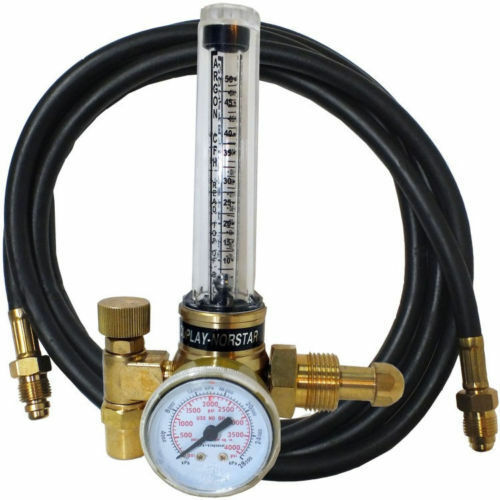
25/75 Mig Tig Welding Regulator Flowgauge 10' Hose Co2 / Argon
⚠️WARNING: Cancer and Reproductive Harm

⚠️WARNING: Cancer and Reproductive Harm
Description: The "25/75 Mig Tig Welding Regulator Flowgauge 10' Hose Co2 / Argon" is a welding gas regulator and flow gauge assembly designed to control the flow of a gas mixture containing 25% Carbon Dioxide (CO2) and 75% Argon. This gas mixture, often referred to as "75/25" or "C25," is commonly used in both MIG and TIG welding applications.
Here are the key features and details:
Gas Mixture (25/75): The "25/75" designation specifies the gas mixture ratio. It consists of 25% Carbon Dioxide (CO2) and 75% Argon. This particular mixture is popular for its versatility and suitability for various welding tasks. The CO2 provides better penetration in MIG welding, while the Argon contributes to a stable arc in TIG welding.
Regulator: The regulator is a critical component of the assembly. It controls the pressure and flow rate of the welding gas, ensuring a consistent and controlled flow to the welding torch. The regulator is adjustable, allowing welders to set the desired gas flow rate for their specific welding application.
Flowgauge: The flow gauge is typically part of the regulator assembly and displays the gas flow rate in units such as cubic feet per hour (CFH) or liters per minute (LPM). This gauge allows welders to monitor and adjust the gas flow to achieve optimal welding results.
10' Hose: The package includes a 10-foot long hose, which serves as the conduit for delivering the gas from the regulator to the welding torch. The length of the hose provides flexibility and maneuverability for the welder during the welding process.
Co2 / Argon: The regulator and hose assembly are suitable for use with both CO2 and Argon gases. This versatility allows welders to switch between these gases depending on the welding application and material being worked on.
Compatibility: It's essential to ensure that the regulator and hose assembly is compatible with the specific welding equipment and torch being used. Proper connections and fittings are crucial for safe and efficient gas delivery.
Description: The "25/75 Mig Tig Welding Regulator Flowgauge 10' Hose Co2 / Argon" is a welding gas regulator and flow gauge assembly designed to control the flow of a gas mixture containing 25% Carbon Dioxide (CO2) and 75% Argon. This gas mixture, often referred to as "75/25" or "C25," is commonly used in both MIG and TIG welding applications.
Here are the key features and details:
Gas Mixture (25/75): The "25/75" designation specifies the gas mixture ratio. It consists of 25% Carbon Dioxide (CO2) and 75% Argon. This particular mixture is popular for its versatility and suitability for various welding tasks. The CO2 provides better penetration in MIG welding, while the Argon contributes to a stable arc in TIG welding.
Regulator: The regulator is a critical component of the assembly. It controls the pressure and flow rate of the welding gas, ensuring a consistent and controlled flow to the welding torch. The regulator is adjustable, allowing welders to set the desired gas flow rate for their specific welding application.
Flowgauge: The flow gauge is typically part of the regulator assembly and displays the gas flow rate in units such as cubic feet per hour (CFH) or liters per minute (LPM). This gauge allows welders to monitor and adjust the gas flow to achieve optimal welding results.
10' Hose: The package includes a 10-foot long hose, which serves as the conduit for delivering the gas from the regulator to the welding torch. The length of the hose provides flexibility and maneuverability for the welder during the welding process.
Co2 / Argon: The regulator and hose assembly are suitable for use with both CO2 and Argon gases. This versatility allows welders to switch between these gases depending on the welding application and material being worked on.
Compatibility: It's essential to ensure that the regulator and hose assembly is compatible with the specific welding equipment and torch being used. Proper connections and fittings are crucial for safe and efficient gas delivery.